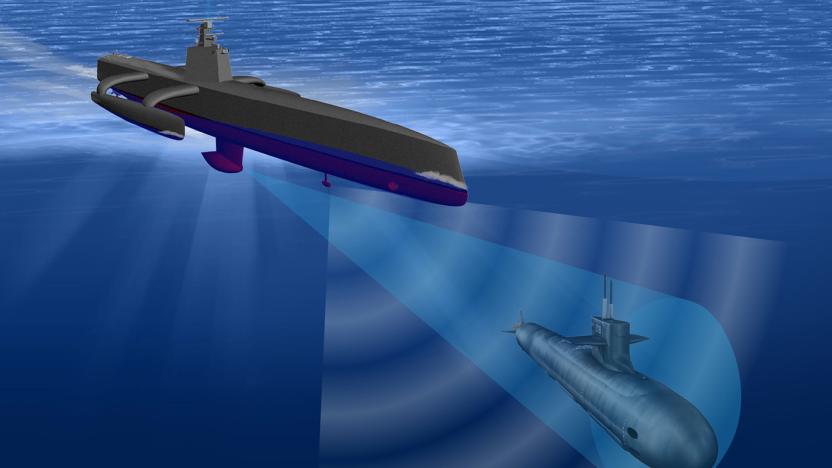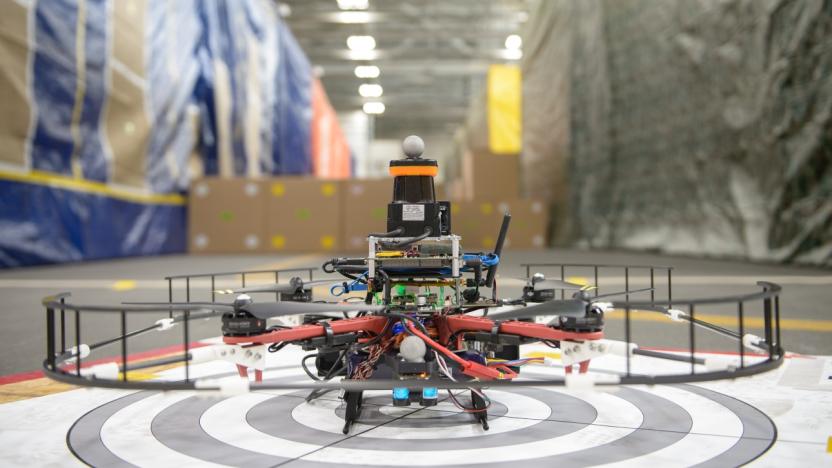Darpa
Latest

ICYMI: Laser-powered spacecraft, upgraded Atlas bot and more
#fivemin-widget-blogsmith-image-139655{display:none;} .cke_show_borders #fivemin-widget-blogsmith-image-139655, #postcontentcontainer #fivemin-widget-blogsmith-image-139655{width:570px;display:block;} try{document.getElementById("fivemin-widget-blogsmith-image-139655").style.display="none";}catch(e){}Today on In Case You Missed It: A professor from California is working on a plan to use photonic propulsion to get a spacecraft to Mars within 72 hours. It would use get the craft off of earth with the power generated by photons leaving a laser.

ICYMI: 3D-printed ears, autonomous DARPA drones and more
#fivemin-widget-blogsmith-image-214941{display:none;} .cke_show_borders #fivemin-widget-blogsmith-image-214941, #postcontentcontainer #fivemin-widget-blogsmith-image-214941{width:570px;display:block;} try{document.getElementById("fivemin-widget-blogsmith-image-214941").style.display="none";}catch(e){} Today on In Case You Missed It: Wake Forest Institute for Regenerative Medicine scientists have 3D-printed living tissue that can be transplanted into living animals, most notably an ear that grew new cartilage and blood vessels once under the skin of a mouse for a few months.

ICYMI: Spacey HoloLens use, spy submarines and more
#fivemin-widget-blogsmith-image-905675{display:none;} .cke_show_borders #fivemin-widget-blogsmith-image-905675, #postcontentcontainer #fivemin-widget-blogsmith-image-905675{width:570px;display:block;} try{document.getElementById("fivemin-widget-blogsmith-image-905675").style.display="none";}catch(e){}Today on In Case You Missed It: DARPA is about to start testing an autonomous submarine called Sea Hunter, designed to find and trail larger submarines for weeks at a time.

DARPA to unveil its 130-foot unmanned robot ship in April
DARPA is christening its autonomous robot ship in April, the agency's director, Arati Prabhakar, has revealed at a media roundtable. That's the same submarine-hunting drone defense contractor Leidos began building in 2014, and the same one that will be steered by software you might have helped develop a few years ago. ACTUV (an acronym for its rather unweildy name: the Anti-Submarine Warfare Continuous Trail Unmanned Vessel) is 132-foot long and weighs 140 tons.

Watch DARPA's tiny drone do 45 MPH indoors, autonomously
It's been a bit since we last saw DARPA's bird-of-prey inspired drone system, but the government's mad science wing hasn't been sitting idle. The Fast Lightweight Autonomy program recently took one of its drones on an indoor test flight where there little quadrocopter that could zoomed around a cluttered warehouse in a Cape Cod Air Force base at 45 MPH -- the target speed and environment the outfit was aiming for back in 2014.

DARPA wants to build wetware so we can mind control computers
Hot damn, our Ghost in the Shell future is getting closer by the day. DARPA announced on Tuesday that it is interested in developing wetware -- implantable brain-machine interfaces (BMI) that will allow their users to control computers with their thoughts. The device, developed as part of the Neural Engineering System Design (NESD) program, would essentially translate the chemical signals in our neurons into digital code. What's more, DARPA expects this interface to be no larger than two nickels stacked atop one another.

ICYMI: DARPA Bots doing chores, VR fight action and more
#fivemin-widget-blogsmith-image-293926{display:none;} .cke_show_borders #fivemin-widget-blogsmith-image-293926, #postcontentcontainer #fivemin-widget-blogsmith-image-293926{width:570px;display:block;} try{document.getElementById("fivemin-widget-blogsmith-image-293926").style.display="none";}catch(e){}Today on In Case You Missed It: A team that placed in the most recent DARPA challenge is still testing its robot, only now the tasks are more house-related. The IHMC has found that they can best tell whether their bot is responding well to new software by seeing how it handles common chores around the garage.

Government testing smart parachutes that stay on target
GPS is not foolproof -- especially on the modern battlefield, where electronic warfare systems can interfere with the satellite guidance. And when packages miss their mark, soldiers often have to venture into hostile territory to retrieve them. That's why the US Army is developing a joint precision airdrop system, or JPADS, that guides equipment towards its target using only visual cues.

DARPA wants help hunting for individual photons
America's mad science division wants the ability to see the building blocks of light, but needs the scientific community's help to do so. The agency is launching one of its famous open calls for knowledge, this time under the auspices of the Fundamental Limits of Photon Detection Program. The project is designed to bring together theoretical scientists and engineers to see if it's possible to build an accurate photon detector. In an ideal world, DARPA wants a gadget that can correctly pick out individual photons -- a technology that would prove beneficial in any number of technologies.

DARPA wants a military drone that can land on small ships
For the longest time, the US Navy has conducted surveillance and reconnaissance missions by launching planes from large aircraft carriers. Those vessels are expensive though, so the Office of Naval Research and DARPA are working on a long-endurance drone that can launch from small ships instead. Project TERN (Tactically Exploited Reconnaissance Node) has now entered phase three, meaning the initial designs are complete and the team is ready to build its first prototype. It's being developed for $93 million by Northrop Grumman, a defense contractor with plenty of experience building nightmare-inducing military assets.

Marines send its 'AlphaDog' robot to the farm
The Legged Squad Support System (LS3, or AlphaDog) won't be part of the near-future Marine corps. Following years of development and improvements through DARPA and Boston Dynamics, the robot was deemed too loud and difficult for deployment. The robo pack-mule was meant to assist soldiers in the field by carrying substantial equipment loads on patrol, with built-in gas engines and voice control adding a degree of freedom compared to older robots. However, when the 'bot was put into demonstrative field tests, Kyle Olson, a spokesman for the Marines' Warfighting Lab explained BigDog's limits were also on show:"As Marines were using it, there was the challenge of seeing the potential possibility because of the limitations of the robot itself," Olson said. "They took it as it was: a loud robot that's going to give away their position."

ICYMI: The best robot news of the year
#fivemin-widget-blogsmith-image-777059{display:none;} .cke_show_borders #fivemin-widget-blogsmith-image-777059, #postcontentcontainer #fivemin-widget-blogsmith-image-777059{width:570px;display:block;}try{document.getElementById("fivemin-widget-blogsmith-image-777059").style.display="none";}catch(e){}Today on In Case You Missed It: We hit just over 120 episodes since our launch in June and from the beginning, we have been obsessed with robot innovation. That's why we put together a special year-end episode of ICYMI, rounding up our very favorite robot stories.

DARPA wants to protect critical infrastructures from cyber attacks
Hackers have been breaking through a lot of government agency's defenses these past years, and DARPA thinks it's high time to do something about it. Pentagon's mad science division has launched a new program called Rapid Attack Detection, Isolation and Characterization (RADICS), which aims to develop innovative technologies that can quickly detect and respond to cyber attacks. Not just any cyber attacks, though: RADICS was specifically created to deflect security threats on critical infrastructures in the US, especially those that are vital to the Department of Defense's missions. The agency likely wants to make sure the government can quickly detect and fight off terrorists and/or hackers trying to switch off the country's electricity or transportation systems.

DARPA wants your crazy robot pitches
DARPA is known for its amazing tech and scary robots. But it knows that somewhere out there, others are thinking of sweet automatons to help the Department of Defense. To that end, it has teamed up with Open Source Robotics Foundation for the Robotics Fast Track (RFT) program to give people outside the government the chance to pitch their robot idea. While it's happy to accept pitches about land and air devices, what it's really interested in is space and maritime hardware. According to DARPA program manager Mark Micire, building for both those environments is incredibly difficult. So, if you have a sweet submarine that can track other objects underwater without cracking under extreme pressure, you might want to hit them up.

ICYMI: Trekkie health scanner, car vending machine and more
#fivemin-widget-blogsmith-image-924600{display:none;} .cke_show_borders #fivemin-widget-blogsmith-image-924600, #postcontentcontainer #fivemin-widget-blogsmith-image-924600{width:570px;display:block;} try{document.getElementById("fivemin-widget-blogsmith-image-924600").style.display="none";}catch(e){}Today on In Case You Missed It: A vending machine for cars (by Carvana) just launched in Nashville, removing the necessity of talking to a car salesman -- or anyone, really -- before driving off in a new ride. Stanford engineers made a health scanner device that can detect a tumor in your body based on the energy vibration that it sends out. And two crowdfunded devices aim to help snoring sleepers put a sock in it. The first, Nora, comes with a pillow that deflates or otherwise moves, to reposition the offending sleeper's head. The other, Silent Partner, is a nose wearable that allegedly creates a quiet zone around the sleeper by sending out canceling sound waves.

Stanford scientists get a little closer to a medical tricorder
Being able to identify problems with a person's body without subjecting them to invasive procedures is the fantasy of all Star Trek doctors. There's even a prize offering a fortune to anyone who can effectively recreate the tricorder technology out in the real world. Now, Stanford scientists think that they've developed a system that, in time, could be used to spot cancerous tumors from a foot away.

DARPA's developing a data network that connects squadrons even when jammed
DARPA issued a Broad Agency Announcement solicitation for a new program called Dynamic Network Adaptation for Mission Optimization (DyNAMO) which aims to keep America's manned (and unmanned) combat aircraft connected even if enemy forces attempt to jam their communications. But that's not as straightforward as it sounds. US aircraft are additionally hindered by the fact that many of the platforms operate on incompatible radio networks using different encryption schemes. And while the DoD has already developed specialized data-link gateways to act as universal translators between them, the gateways' bandwidth is limited.

DARPA's new program plans to stimulate your nerves for self-healing
DARPA wants to modulate your nerves. The research agency's new Electrical Prescriptions (ElectRx) program is designed to discover the science and the technology that will stimulate the peripheral nervous system to detect and fight diseases. The nerves in this complex system are critical to all sensory and motor signal communications in the body. They constantly maintain and monitor your health status. When these nerves pick up a disruption, like an infection or injury, they trigger an automatic response in the brain or spinal cord that adjusts the workings of an affected organ to activate healing. But sometimes, when a disease compromises this natural flow of signals, the nerves produce a signal of pain or lead to autoimmune disorders, even diabetes. ElectRx is designed to address this glitch in the human system.

DARPA wants to build vehicles that disappear after delivering supplies
What if the vehicle delivering the goods to a remote village or group of soldiers could just vanish after it made the drop? Sounds crazy, right? Well, DARPA is hoping to do just that. The research unit it looking to develop solutions that can carry supplies to their intended destinations and then disappear. Named for the story of a man who's wings of feathers and wax melted when he flew too close to the sun, DARPA's new ICARUS program that'll examine the possibilities is an extension of its VAPR project. Of course, we expect DARPA is aiming for a more positive outcome. VAPR, which stands for Vanishing Programmable Resources, has developed self-destructing electronic components since it began two years ago. Aside from the obvious military uses, DARPA says a vehicle that vanishes in to thin air could also offer an unmanned solution for taking critical supplies to hard to reach areas in the aftermath of events like a natural disaster. Once the load is delivered, personnel wouldn't have to worry about getting the vehicle back out of the area. [Image credit: SEBASTIEN BOZON/AFP/Getty Images]

ICYMI: Airbag moto-jacket, robotic landing gear and more
#fivemin-widget-blogsmith-image-582118{display:none;} .cke_show_borders #fivemin-widget-blogsmith-image-582118, #postcontentcontainer #fivemin-widget-blogsmith-image-582118{width:570px;display:block;} try{document.getElementById("fivemin-widget-blogsmith-image-582118").style.display="none";}catch(e){}Today on In Case You Missed It: Newly unveiled robotic landing gear is enabling helicopters to land on uneven ground. But that's DARPA for you; always down with the militarized robot inventions. Meanwhile motorcyclists have a new jacket that not only looks legit but uses sensors to deploy an internal airbag if danger is detected. And a Kickstarter project for the SteadXP is interesting because it can make give most digital cameras a steadicam look, no matter how shaky or untrained the operator.









